Symphyotrichum lanceolatum facts for kids
Quick facts for kids Symphyotrichum lanceolatum |
|
|---|---|
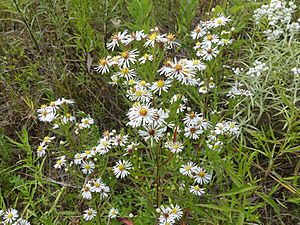 |
|
 |
|
| Conservation status | |
| Scientific classification | |
| Genus: |
Symphyotrichum
|
| Species: |
lanceolatum
|
 |
|
| Native range of Symphyotrichum lanceolatum. For infraspecies ranges, see text. | |
| Synonyms | |
|
Basionym
Infraspecies
Subsp. lanceolatum
Aster abbreviatus Nees
Aster bellidiflorus Willd. Aster bellidiflorus var. rubricaulis DC. Aster cornuti J.C.Wendl. ex Nees Aster cornuti Mill. ex Nees Aster eminens Lindl. Aster lamarckianus Nees Aster lanceolatus var. monocephalus Kuntze Aster lanceolatus var. simplex (Willd.) A.G.Jones Aster lanceolatus subsp. simplex (Willd.) A.G.Jones Aster laxifolius var. laetiflorus Torr. & A.Gray Aster laxus Willd. Aster pallens Willd. Aster paniculatus var. acutidens E.S.Burgess Aster paniculatus var. bellidiflorus E.S.Burgess Aster paniculatus var. cinerascens Fernald Aster paniculatus var. lanatus Fernald Aster paniculatus var. polychrous Lunell Aster paniculatus var. simplex E.S.Burgess Aster simplex Willd. Aster simplex var. estuarinus B.Boivin Aster simplex var. ramosissimus (Torr. & A.Gray) Cronquist Aster stenophyllus Lindl. Aster tenuifolius var. bellidiflorus (Willd.) Torr. & A.Gray Aster tenuifolius var. ramosissimus Torr. & A.Gray Symphyotrichum simplex (Willd.) Á.Löve & D.Löve Var. hesperium
Aster coerulescens var. laetevirens (Greene) Cronquist
Aster coerulescens var. wootonii Wiegand Aster durus Lunell Aster fluvialis Osterh. Aster foliaceus var. hesperius (A.Gray) Jeps. Aster hesperius A.Gray Aster hesperius var. laetevirens (Greene) Cronquist Aster hesperius var. wootonii Greene Aster laetevirens Greene Aster lanceolatus subsp. hesperius (A.Gray) Semple & Chmiel. Aster lautus Lunell Aster lautus var. prionoides Lunell Aster osterhoutii Rydb. Aster wootonii Greene Symphyotrichum hesperium (A.Gray) Á.Löve & D.Löve Symphyotrichum lanceolatum subsp. hesperium (A.Gray) G.L.Nesom Var. hirsuticaule
Aster lanceolatus var. hirsuticaulis Semple & Chmiel.
Var. interior
Aster interior Wiegand
Aster lanceolatus var. interior (Wiegand) Semple & Chmiel. Aster lanceolatus var. interior (Wiegand) A.G.Jones Aster lanceolatus subsp. interior (Wiegand) A.G.Jones Aster simplex var. interior (Wiegand) Cronquist Var. latifolium
Aster lanceolatus var. latifolius Semple & Chmiel.
|
|
Symphyotrichum lanceolatum (formerly Aster lanceolatus) is a species of flowering plant in the family Asteraceae native to North America. Common names include lance-leaved aster, panicled aster, and white panicled aster. It is a perennial, herbaceous plant that may reach 1.5 meters (5 feet) tall or more, sometimes approaching 2 meters (6.6 feet). It has a stout rhizome and can spread to form a clonal colony. The species is currently divided into five varieties which have minor differences in appearance and vary in chromosome counts as well as distribution, with some overlap.
As composite flowers, each flower head has many tiny florets put together into what appear as one, as do all plants in the family Asteraceae. The flowers of panicled aster have 16–50 white ray florets that are up to 10 millimeters long and sometimes tinged pink or purple. The flower centers begin as yellow and become purple as they mature. There are roughly 20–40 disk florets in the center of each flower head, each with five lobes that may spread when open. The leaves are generally hairless but may feel slightly rough to the touch on the top because of tiny bristles. Branching of the inflorescences is in panicles.
Symphyotrichum lanceolatum occurs in a wide variety of mostly moist and open habitats, including riparian areas (areas between land and a river or stream), meadows, and ditches. It is a conservationally secure species whose late-summer and fall appearing flowers play an important role for late-season pollinators and nectar-seeking insects such as bumblebees, wasps, and hoverflies. In addition to being used by indigenous peoples for medicinal purposes, it has been cultivated as an ornamental garden plant and used in the cut flower industry.
This species spreads extensively via its rhizomes and can reproduce by wind-blown seed. Because of its rhizomatic spreading and its production of chemicals that can be detrimental to other plants around it, the species can do damage to ecosystems outside of its native range, as it has in Europe where it has been introduced.
Contents
Name
Symphyotrichum lanceolatum is commonly known as lance-leaved aster, panicled aster, white panicled aster, tall white aster, eastern line aster, lance-leaf aster, and white-panicle aster. Along with other asters that bloom in the fall, Symphyotrichum lanceolatum may be called a Michaelmas Daisy, and narrow-leaf Michaelmas daisy is also one of its common names. S. lanceolatum var. interior has a common name of interior white aster, and S. lanceolatum var. latifolium has a common name of broadleaf panicled aster. S. lanceolatum var. hesperium common names include western line aster, western willow aster, Wooten's aster, and Siskiyou aster. Another species in the family Asteraceae, Eucephalus glabratus, is also commonly known as Siskiyou aster.
Aster comes from the Ancient Greek word ἀστήρ (astḗr), meaning star, referring to the shape of the flower. The word aster was used to describe a star-like flower as early as 1542 in German physician and botanist Leonhart Fuchs' book De historia stirpium commentarii insignes, Latin for Notable Commentaries on the History of Plants. An old common name for Astereae species using the suffix -wort is starwort, also spelled star-wort or star wort. An early use of this name can be found in the same work by Fuchs as Sternkraut, translated from German literally as star herb.
The specific epithet (second part of the binomial name) lanceolatum is a Latin adjective meaning "lance-shaped." The genus name Symphyotrichum is a combining of Ancient Greek words meaning "junction of hair."
Description
This perennial herb has a thick, erect stem that often grows 1.5 meters (5 feet) tall or more, sometimes approaching 2 meters (6.6 feet). It has a stout rhizome and can spread to form a colony. The leaf blades have winged petioles and may sheath the stem at their bases. The largest leaves, near the base of the plant, are up to about 15 centimeters (6 inches) long. Those higher on the stem are smaller. The lower leaves may have toothed edges. The inflorescence is usually a large, branching array of many flower heads of varying size. There are 16 to 50 ray florets per head, each measuring 3 to 14 millimeters long, in shades of blue, pink, or white. The disk florets bloom yellow and turn purple.
Chromosomes
Symphyotrichum lanceolatum has a base number of x = 8. Tetraploid, pentaploid, hexaploid, septaploid, and octaploid cytotypes with respective chromosome counts of 32, 40, 48, 56, and 64 have been reported, depending on the infraspecies, as follows:
- S. lanceolatum var. hesperium: 2n = 8x = 64.
- S. lanceolatum var. hirsuticaule: 2n = 4x = 32.
- S. lanceolatum var. interior: 2n = 6x = 48 and 2n = 8x = 64.
- S. lanceolatum var. lanceolatum: 2n = 4x = 32, 2n = 5x = 40, 2n = 6x = 48, 2n = 7x = 56, and 2n = 8x = 64.
- S. lanceolatum var. latifolium: 2n = 8x = 64.
Taxonomy
Symphyotrichum lateriflorum is classified in the subgenus Symphyotrichum, section Symphyotrichum, subsection Dumosi. It is one of sixteen "bushy asters and relatives".
This species may be divided into two subspecies and five varieties:
- S. lanceolatum subsp. hesperium
- S. lanceolatum var. hesperium - northern Canada, western United States and northwestern Mexico
- S. lanceolatum subsp. lanceolatum
- S. lanceolatum var. hirsuticaule - great lakes region of Canada and the United States
- S. lanceolatum var. interior - eastern Canada and northeastern United States
- S. lanceolatum var. latifolium - eastern Canada and eastern United States
- S. lanceolatum var. lanceolatum - eastern and central Canada and United States, also introduced to Europe
The hybrid of this species with Symphyotrichum novi-belgii, known as Sympyotrichum × salignum, originates in cultivation but is now naturalized in Europe. Hybrids have also been reported with S. boreale, S. laeve, S. lateriflorum, S. puniceum and S. racemosum.
Symphyotrichum lanceolatum was formerly included in the large genus Aster as Aster lanceolatus. However, this broad circumscription of Aster is polyphyletic and the North American asters are now mostly classified in Symphyotrichum and several other genera.
Distribution and habitat
Symphyotrichum lanceolatum is native to much of Canada, the United States, and northwestern Mexico in Baja California, Sonora and Chihuahua. In its native range, it occurs in a wide variety of mostly moist, open habitats, including riparian areas, meadows, and ditches. Native distribution and habitat varies among the infraspecies, and details are shown in the table "Distribution and habitat among species and infraspecies."
Symphyotrichum lanceolatum has been introduced and naturalized in many parts of Europe, from Belgium to Serbia to Latvia, where it occurs in disturbed man-made habitats and riparian areas as an invasive species. However, it is not on the European Union's List of invasive alien species of Union concern.
| Native range map | Native distribution | Habitat | Elevation | |
|---|---|---|---|---|
| Species as a whole | 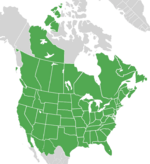 |
Canada and the United States except Yukon, Nunavut, Alaska, Hawaii, and Delaware; Mexican states of Baja California, Sonora, and Chihuahua. | See infraspecies | See infraspecies |
| Var. hesperium |  |
Canadian provinces and territories of Northwest Territories, British Columbia, Alberta, Saskatchewan, Manitoba, Ontario, and Quebec; in Wisconsin east of the Mississippi River, in all U.S. states west of the Mississippi River except Alaska, Hawaii, Missouri, Arkansas, and Louisiana; Mexican states of Baja California, Sonora, and Chihuahua. | On the edges of streams in prairies, wet meadows, open slopes of mountainous pine forests, roadside ditches; can live in lime (chalky) soils | 10–2,700 m (33–8,858 ft) |
| Var. hirsuticaule | 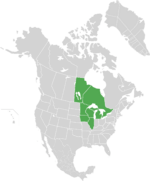 |
Only in the Canadian provinces of Manitoba and Ontario and the U.S. states of Minnesota, Iowa, Wisconsin, Illinois, and Michigan. | "Mucky soils on glacial deposits" | 100–300 m (328–984 ft) |
| Var. interior | 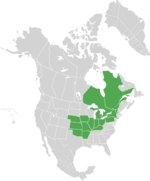 |
Canadian provinces of Ontario and Quebec; and, the U.S. from Nebraska to Pennsylvania (including Michigan), up to New York and Vermont, back down to Kentucky and only as far south as Arkansas, and as far west as Oklahoma. | Along streams in lowlands | 10–400 m (33–1,312 ft) |
| Var. lanceolatum | 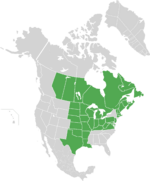 |
Canadian provinces except British Columbia (no territories); in the U.S., from North Dakota east to Maine excluding New York, south to Virginia excluding Delaware, west to Kansas, and the four states south of Kansas — Oklahoma, Arkansas, Louisiana, and Texas. | Stream banks, thicket borders, meadows, fields, and ditches | 0–900 m (0–2,953 ft) |
| Var. latifolium | 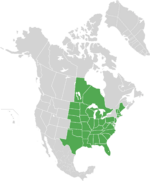 |
Manitoba and Ontario; in the U.S., all states east of the Mississippi River except New York and Delaware, all states on the west Mississippi River border, and the states directly west of those states (from North Dakota in the north to Texas in the south). | Thickets, deciduous woods borders, stream banks, and ditches | 0–800 m (0–2,625 ft) |
Ecology
In addition to dispersal by wind-blown seed, Symphyotrichum lanceolatum spreads extensively by rhizomes to create large clonal colonies. Although these clones do not dominate habitats in North America, growing in association with grasses, goldenrods, and other asters, in Europe it is an invasive species that excludes native plants in riparian habitats. This invasiveness has been linked to allelopathic compounds in S. lanceolatum tissue and their effect on native European plants. Viable seed production in Europe seems to be limited, and the species largely spreads there via rhizomes.
The species is visited by a wide variety of pollinating insects, including bees, flies, moths, and wasps. Cross-fertilization is usually required to produce viable seed, and as such, large clones may have low seed production.
Pests and diseases
Several midge species are known to form galls on Symphyotrichum lanceolatum where their larvae can develop, including Rhopalomyia asteriflorae in the flowers or buds resulting in their stunted growth, and Rhopalomyia strobiligemma.
The leaf-blister gall midge Asteromyia paniculata and the fungus Schlerotium asteris have a symbiotic relationship on the leaves in that the fungus gains additional nutrition from the larva and, in turn, gives some shelter to the midge.
Leaf-mining insects known to feed on this species include Sumitrosis inaequalis, Ophiomyia curvipalpis, Phytomyza albiceps, Microrhopala xerene, and Sumitrosis inaequalis. Younger instars of gorgone checkerspot caterpillars (Chlosyne gorgone) will feed on S. lanceolatum.
Conservation
NatureServe lists the species Symphyotrichum lanceolatum as a whole as Secure (G5) worldwide, Vulnerable (S3) in Iowa, and Imperiled (S2) in North Carolina and Newfoundland. S. lanceolatum subsp. hesperium, S. lanceolatum subsp. lanceolatum, S. lanceolatum var. interior, and S. lanceolatum var. latifolium are all listed as a Secure Subspecies (T5) globally. NatureServe has no global ranking for S. lanceolatum var. hirsuticaule.
In individual states and provinces of the United States and Canada, Symphyotrichum lanceolatum subsp. hesperium is Vulnerable (S3) in Wyoming, and Critically Imperiled (S1) in Texas; S. lanceolatum var. interior is Possibly Extirpated (SH) in New York state and Quebec, and Critically Imperiled (S1) in New Jersey; and, S. lanceolatum var. latifolium is Vulnerable (S3) in Ontario and Georgia. S. lanceolatum var. hirsuticaule has no vulnerable or critical state or province rankings.
Uses
Symphyotrichum lanceolatum may be a minor weed in agricultural fields.
Within its native range, the species was used by indigenous peoples for a variety of medicinal purposes. In the American Southwest, the Zuni people used this plant for wounds and nosebleed. The Iroquois in what is now Eastern Canada used it to treat fever.
Symphyotrichum lanceolatum is also cultivated as an ornamental garden plant and may be used in the cut flower industry.




